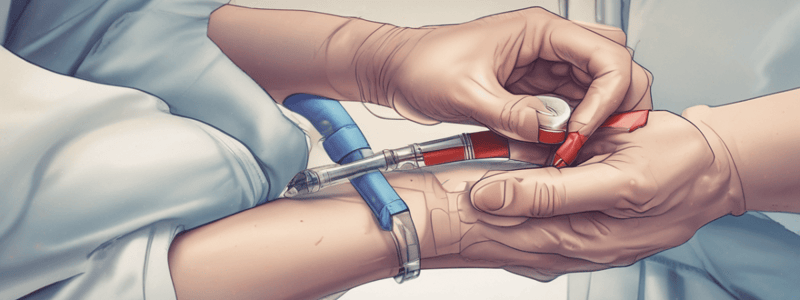Podcast
Questions and Answers
What is the main purpose of a tourniquet in phlebotomy?
What is the main purpose of a tourniquet in phlebotomy?
- To identify an artery
- To restrict arterial blood flow
- To locate a vein
- To restrict venous blood flow (correct)
Where is the tourniquet applied in phlebotomy?
Where is the tourniquet applied in phlebotomy?
- Above the Antecubital fossa (correct)
- Below the elbow
- At the Antecubital fossa
- On the wrist
What is the most common site for venipuncture?
What is the most common site for venipuncture?
- Wrist
- Arm
- Hand
- Antecubital fossa (correct)
How long should a tourniquet be left on?
How long should a tourniquet be left on?
When should the tourniquet be removed?
When should the tourniquet be removed?
What three things are done together in tourniquet tying?
What three things are done together in tourniquet tying?
Why should the tourniquet be tied smoothly and easily?
Why should the tourniquet be tied smoothly and easily?
What is the purpose of the Basilic vein in the Antecubital fossa?
What is the purpose of the Basilic vein in the Antecubital fossa?
Flashcards are hidden until you start studying
Study Notes
Tourniquet Tying in Phlebotomy
- A tourniquet is a constrictive band used to restrict venous blood flow, not arterial blood flow, during phlebotomy procedures to facilitate vein identification.
Purpose of Tourniquet
- Used to restrict venous blood flow, making it easier to identify a vein.
- Also used in life-threatening blood loss situations to restrict both arterial and venous blood flow.
Venipuncture
- Venipuncture is the most common method of blood collection.
- The most common site for venipuncture is the Antecubital fossa (inner forearm, inner side of the elbow).
Veins of Interest
- Three veins of interest in the Antecubital fossa are:
- Cephalic (closer to the top of the Antecubital fossa)
- Basilic (closer to the belly of the patient)
- Median Cubital (middle vein)
Applying the Tourniquet
- The tourniquet is applied approximately 2 inches above the elbow (or above the Antecubital fossa).
- Should not be left on for more than 1-2 minutes.
Tourniquet Tying and Removal
- Tourniquet tying is done in conjunction with palpating the site and clenching the patient's fist.
- The tourniquet must be removed once a potential site has been identified.
- Tying should be smooth, easy, and without jerky movements.
- Easy removal is essential to prevent accidentally pulling out the needle from the vein.
Studying That Suits You
Use AI to generate personalized quizzes and flashcards to suit your learning preferences.




